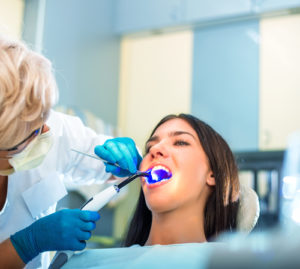By Laura Thill
As curing technology has become increasingly sophisticated, curing lights have become more and more diverse, leading dentists to question which light solution and bulk fill composite best meets the needs of their practice.

Curing lights today are an integral part of modern dentistry, notes Shashikant Singhal, BDS, MS, director of professional services, Ivoclar Vivadent, Inc. “Nowadays, curing lights are used not only to polymerize dental composites, but also to cure dental adhesives; resin cements in various clinical situations, like curing through ceramic restorations; post and cores; and deep restorative cavities,” he says. “Therefore, to provide an ideal restoration with long-term clinical success, it is critical for a clinician to select a curing light that meets all the requirements.” Curing light technology features quartz-tungsten halogen, plasma arc, argon laser and most contemporary LED curing lights, he adds. But, that begs the question: How can dental providers determine the ideal curing light solution for the needs of their practice?
The science behind the cure
The rapid changes in light curing technology in recent years – and the impact this has had on the chemistry of light-cured resin-based materials – makes it more important than ever for dentists to fully understand the curing process, as well as challenges. “Clinicians must understand the chemistry of the composite, their curing lights and the polymerization technique, as inadequate polymerized composite restorations tend to show high wear, chipping, catastrophic fracture and compromised esthetic by staining,” says Singhal.
For starters, light cured resin-based materials consist of a number of ingredients, including resin matrix; filler particles coupled with matrix, using coupling agents; and photo-initiators, according to Singhal. “The photo-initiators absorb light energy of specific wavelengths from curing light units,” he explains. “The energy absorbed excites the molecules and enables the formation of free radicals; this, in turn, initiates polymerization.” For years, clinicans relied on the photo-initiator, Camphorquinone, he points out. However, Camphorquinone has a yellowish color, prompting the use of lighter colored initiators, such as Lucirin TPO and phenyl-propanedione (PPD). Recently, Ivoclar Vivadent patented a new photo-initiator, Ivocerin, designed for use in bulk fill technology and color stable resin cements.
 When purchasing a new curing light, Singhal looks for light units that offer a broad wavelength spectrum, high power intensity and a homogenous beam profile – attributes that ensure the curing light unit will adequately polymerize all resin-based material, he notes. “Photo-initiators absorb light energy of a specific wavelength spectrum to facilitate the polymerization,” he says. “Most – but not all – contemporary LED curing lights have a narrow wavelength spectrum of 430 – 480 nm. The absorption spectrum of Camphorquinone (CQ) is between 390 – 510 nm, and Ivocerin is between 370-460 nm.” By comparison, Lucirin TPO and PPD absorb light in the range of less than 430 nm, and the materials may not be cured properly using a narrow spectrum LED curing light, he adds.
When purchasing a new curing light, Singhal looks for light units that offer a broad wavelength spectrum, high power intensity and a homogenous beam profile – attributes that ensure the curing light unit will adequately polymerize all resin-based material, he notes. “Photo-initiators absorb light energy of a specific wavelength spectrum to facilitate the polymerization,” he says. “Most – but not all – contemporary LED curing lights have a narrow wavelength spectrum of 430 – 480 nm. The absorption spectrum of Camphorquinone (CQ) is between 390 – 510 nm, and Ivocerin is between 370-460 nm.” By comparison, Lucirin TPO and PPD absorb light in the range of less than 430 nm, and the materials may not be cured properly using a narrow spectrum LED curing light, he adds.
It’s also important to consider the amount of energy required to adequately polymerize the material, says Singhal. “This is calculated by the power intensity of a curing light exposed over a period,” he explains. To ensure adequate polymerization, most manufacturers recommend between 10 and 20 seconds of light polymerization for a resin composite, with a curing light power intensity of 1000 mW/cm2. “The light units with lower power intensity can result in compromised polymerization of a resin composite,” he points out.
Finally, it is also critical to have uniform distribution of light – or beam homogeneity – at the end of the curing light probe to ensure the composite material is uniformly and adequately polymerized, he says. “A non-uniform distribution of light energy results in localized hot spots of adequate energy, resulting in inadequate polymerization of the remaining exposed composite surface. These lights tend to be more economical, but they have limitations, such as a non-homogenous beam profile or a narrow spectrum, which can compromise the clinical outcome.”
Ivoclar’s Bluephase® Style curing light from Ivoclar Vivadent meets Sighal’s standards for wavelength spectrum, power intensity and a homogenous beam profile. “Bluephase Style curing lights are equipped with advance polywave light emitting diode technology, enabling them to achieve an optimal broad spectrum wavelength range from 385 – 515 nm, with high power intensity of 1,200 mW/cm2,” he says. “Polywave technology serves as a benchmark for many clinicians, as it enables them to cure all dental restorative materials with different photo-initiators systems (e.g. Camphorquinone, Lucirin TPO, phenylpropanedione (PPD), Ivocerin etc.). Additionally, Bluephase Style curing lights are equipped with a parallel light guide, which helps reduce light-intensity loss when the light guide needs to be held at distances from the material to be irradiated.” The Bluephase Style’s light guide, in combination with the unit’s ergonomic pen design, ensures easy access to the entire mouth, he adds.
Myths and challenges
Few non-surgical restorative procedures today do not require the light polymerization of dental materials. “While there has been much attention to the details of diagnosis, clinical procedures and the development of improved adhesives and resins, light polymerization is often taken for granted,” says Singhal. Some clinicians may not fully understand the curing process, he notes. “Not all curing lights are the same, and not all hard materials are completely polymerized, and it’s important that dentists be aware of this,” he says.
Indeed, there is much variance from one curing light to another, Singhal points out. Higher end curing light units, designed with a higher quality LED curing light, tend to provide consistent power output over longer periods of time, he notes. It’s equally important for dental offices to measure power output of their curing lights regularly. “Dental manufacturers invest in a high-quality radiometer devices like an integrating sphere, which can measure power output of a curing light with accuracy of ± 5 percent, however these devices are expensive,” he adds. “Other less expensive chairside radiometers are also available.”
Again, dentists get what they pay for, and the less expensive, conventional hand held radiometers fail to provide accurate light intensity measurements, in his opinion. “Most handheld radiometers are only capable of measuring power output over a small area of the probe, resulting in an inaccurate or false reading,” he says. “In contrast, Ivoclar Vivadent’s Bluephase® meter II features a surface sensor, permitting the meter to measure power output over the radiating surface of the curing light probe with an accuracy of ± 10 percent.”
Investing in higher end equipment and materials not only helps ensure optimal results, it often saves dentists – and patients – time, Singhal notes. For instance, using traditional resin-based filling material requires a longer time to polymerize increments of composites, while restoring deep cavities, he says. “Factors such as air bubbles, compromised adaptation of layers, contamination and heat generation from multiple polymerization cycles during the restorative procedure can further compromise the clinical outcome,” he explains. “Other factors, like composite shades and translucencies, can also affect the light polymerization reaction. Lab studies have shown that darker, opaque dentin shades require higher light energy for polymerization compared to lighter, more translucent enamel shades. Conventional initiator systems alone are unable to cure increments exceeding 1.5 – 2 mm. So, it’s critical that clinicians consider all variables during polymerization of these materials.”
Bulk fill composites
Dentistry is quickly changing, notes Singhal, and with that comes the availability of increasingly efficient products – including bulk fill composites. “These materials have higher depth of cure compared to conventional composites and allow clinicians to restore cavities in thick increments of 4-5 mm, decreasing chairside time without compromising clinical outcome.” Dental manufacturers can achieve an increased depth of cure by increasing either the concentration of photo-initiators, curing time or translucency of the material, he says. “Increasing the concentration of photo-initiators and polymerization time will enhance reactivity of the material to light energy, whereas increased translucency allows deeper light penetration to achieve a higher depth of cure,” he explains. That said, increasing photo-initiator concentrations can decrease working time, while an increased polymerization time means greater heat generation from the curing light unit and a longer chairside time, and increased translucency can compromise the esthetics of the restoration.
Unlike conventional approaches, which employ a composite layering technique, Ivoclar Vivadent’s Tetric® EvoCeram Bulk Fill composite – a light cured composite indicated for direct restorations in posterior teeth and for class V restorations – has a sculptable viscosity and is formulated to be light polymerized in bulk increments of up to 4 mm, notes Singhal. “The time required to adequately polymerize this material from a light curing unit with an intensity greater than 1000 mW/cm2 is only 10 seconds,” he says. “Tetric EvoCeram Bulk Fill includes a patented light initiator/polymerization booster, Ivocerin, for a high depth of cure. It combines advanced composite-filler technology to achieve the desired mechanical properties and high surface finish; a pre-polymer shrinkage stress reliever to minimize polymerization shrinkage stress; and a light sensitivity filter for adequate working time.
“Ivocerin is truly an innovation in photo-polymerization technology,” he continues. “Traditional photo-initiator systems, such as Camphorquinone, have limitations, such as low quantum efficiency (low sensitivity to light). In addition, the use of amine-based co-initiators with Camphorquinone may cause discoloration of composite material due to the oxidation of the remaining amine component. To overcome these challenges, and to innovate an ideal photo-initiator technology for contemporary bulk fill materials, Ivoclar Vivadent collaborated with Professor R. Liska of the Vienna University of Technology to develop and patent the germanium-based photo-initiator, Ivocerin. Unlike conventional photo-initiators, Ivocerin is approximately ten times more reactive to the curing light, thereby requiring less light energy. The absorption spectrum of Ivocerin ranges from 370 nm – 460 nm, so light can be activated using commercially available curing light units. And, Ivocerin’s amine free chemistry ensures that composite materials are highly color stable.”
For Ivoclar Vivadent Inc., innovation comes down to the ability to perfect strategies, products and services, Singhal points out. “We strive to anticipate our customers’ needs, and we continually challenge our research and development team to find better, more effective and efficient solutions to meet clinicians’ requirements.
“Ivoclar’s research and development team includes chemists, researches and well-trained dental professionals, who understand what dentists truly need to run a successful practice,” Singhal says. “Once a product is developed, our team creates educational content, such as scientific literature and animated and clinical tip videos, which are available on the Ivoclar Vivadent North American website.” These resources – as well as online training sessions – are available to dentists, as well as their staff and their distributor sales reps, he adds. “Our longtime customer service support, which includes experienced clinicians, registered dental hygienists/assistants and trained customer service representatives, is always available. We mean it when we say, ‘Customer satisfaction is guaranteed!’”

